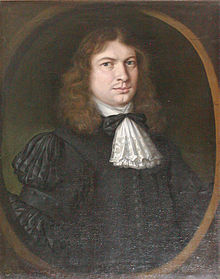Þormóður Torfason
Thormodus Torfæus (Latinized Thormod (us) Torfaeus * May 27 . Jul / 6. June 1636 greg. , † 31 January 1719 ) was an Icelandic historian . He lived in Kopervik on Karmøy in Norway . He was a royal Danish historian, the first in modern times. He collected medieval texts and translated Icelandic manuscripts into Danish .
Life
Þormóður was born on Engey in Iceland in 1636 . He studied at the University of Copenhagen . In 1660 he was appointed royal translator of old Icelandic manuscripts. In a letter dated May 17, 1662, the king instructed him to collect old manuscripts in Iceland. 1664 appointed him King Friedrich III. as clerk for the administrative district of Stavanger and in 1682 as royal historian for Norway. In 1665 he married Anna Stangeland from Kopervik, who came from a Stavanger family and owned goods there. The marriage remained childless, but Þormóður had many illegitimate children. He was a bellicose man. After a shipwreck near Skagen in 1671 he got into an argument with a guest in an inn and killed him with his sword. For this he was sentenced to death. Since it was apparently a matter of self-defense, he was pardoned by the Danish Supreme Court. But he was also committed to other people and, among other things, prevented a Norwegian woman from being burned as a witch .
His grave is under the choir of Olav's Church in Avaldsnes on Karmøy .
The historian
In 1705 he published the Historia Vinlandiae antiquae , in 1706 the Gronlandia antiqua and in 1711 the Historia rerum Norvegicarum , which covered the period from the beginning to the year 1387. Its focus is on the early Middle Ages. He had many manuscripts from the Middle Ages, especially the old sagas , and was the first to use them as source material. From this he created a coherent Latin text. He also wrote a variety of Latin histories about the Middle Ages as well as about modern times. His research became known to a wide audience in Europe. Everything that was written about Norwegian history in the following century was largely based on his work. He also wrote a story about the Faroe Islands and the Orkneys .
In Scandinavian historiography, Torfason is considered to be the founder of the so-called Icelandic School, which used Icelandic sagas as historical sources, not only for the settlement of Iceland and the immediately preceding period, but also for Scandinavian prehistory.
The inclusion of the sagas was based on Torfason's criticism of the sources of his famous predecessor Saxo Grammaticus on his historical work Gesta Danorum. The heroic chants to which Saxo refers are not available in the form he has reproduced, the rune stone inscriptions are mutilated and difficult to interpret, so that the first half of the Gesta deserve no faith. He draws up a list of the Scandinavian kings, starting with Odin and his son Skiold , who are said to have ruled a few years before the birth of Christ. He rejects the rulers that Saxo names before this time, and also makes numerous adjustments and deletions among the rulers after the birth of Christ.
In his work, Torfason represents an undisguised Norwegian point of view at a time when Norway was still a Danish province. The selection of quotations from the sagas indicates a first Norwegian national consciousness. Likewise, Torfason was the first to try to legitimize the existence of a Norwegian nation.
His 2000-page work is considered the first attempt at writing history using the sagas and a bridge to the more recent historians Gerhard Schøning and Peter Andreas Munch. He was therefore also called the father of Norwegian historiography. Nevertheless, it took centuries for a Norwegian study of history to become established. His lack of source criticism, particularly that he believed in sorcery, has hurt his fame very much. This overshadowed his contribution to a systematic and methodical presentation of history. But it is not only the richness of detail in his Historia rerum Norvegicarum that has preserved information that would otherwise have been lost in the great fire in Copenhagen in 1728, but also his habit of copying the Icelandic manuscripts on Karmøy first before sending them to Copenhagen. For fire safety reasons, he did not keep them in his house, but in a separate cellar on the Stangeland farm near Stavanger.
It is only very recently that beginntormóður Torfason has started to be viewed more differently.
His Latin Historia rerum Norvegicarum was translated into Norwegian by the Thormod Torfaeus Foundation and published in full in 2005.
Works
- Commentatio historica de rebus gestis Færeyensium seu Færöensium . [sic] Copenhagen 1695
- Orcades seu rerum Orcadensium historiae libri tres . Copenhagen 1697
- Series dynastarum et regum Daniae . Copenhagen 1702
- Historia Hrolfi Krakii inter potentissimos in ethnicismo Daniae reges celeberrimi . Copenhagen 1705
- Historia Vinlandiae antiquae seu partis Americae septentrionalis . Copenhagen 1705
- Gronlandia antiqua seu veteris Gronlandiae descriptio . Copenhagen 1706
- Trifolium historicum seu dissertatio historico-chronologico-critica de tribus potentissimis Daniae regibus Gormo Grandaevo, Haraldo Caerulidente et Sveno Furcatae (seu Admorsae) Barbae . Copenhagen 1707
- Historia rerum Norvegicarum, 4 volumes, Copenhagen 1711
literature
- Peter Frederik Suhm , Jón Jónsson, Hannes Finnsson: Torfaeana sive Thormodi Torfaei Notae posteriores in seriem regum Daniae, epistolae Latinae et index in seriem regum Daniae . Copenhagen 1777, archive.org
- John Erichsen [= Jón Eiríksson]: Thormod Torfesens Levnetsbeskrivelse . Copenhagen 1788, archive.org
| personal data | |
|---|---|
| SURNAME | Þormóður Torfason |
| ALTERNATIVE NAMES | Torfaeus, Thormod; Torfason, Þormóður |
| BRIEF DESCRIPTION | Icelandic historian |
| DATE OF BIRTH | June 6, 1636 |
| PLACE OF BIRTH | Engey (Iceland) |
| DATE OF DEATH | January 31, 1719 |
